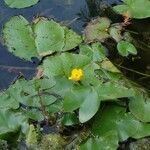A herb. It grows in water. The rhizomes or underground stems are stout and 1-3 cm across. The leaf stalk is 20-50 cm long. It is hairy. The leaf blade floats. It is broadly oval and 6-17 cm long by 6-12 cm wide. It can be hairy underneath. The base is heart shaped and the lobes are separated from each other. The flowers are 1-4.5 cm across. The fruit stalk is 40-50 cm long and hairy. The sepals ate yellow. The fruit is 1-2 cm across. The seeds are brown and oblong. They are 3-5 mm across.


